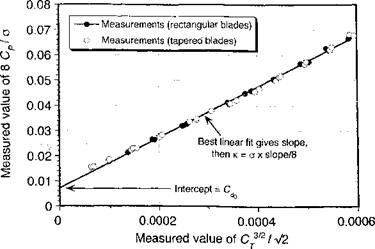Worked Example 2
A tilt-rotor aircraft has a gross weight of 45,000 lb (20,400 kg). The rotor diameter is 38 ft (11.58 m). On the basis of the momentum theory, estimate the power required for the aircraft to hover at sea level on a standard day where the density of air is 0.002378 slugs ft-3 or 1.225 kg m~3. Assume that the figure of merit of the rotors is 0.75 and transmission losses amount to 5%.
A tilt-rotor has two rotors, which are each assumed to carry half of the total aircraft weight, that is, T = 22,500 lb. For each of the rotors, the disk area is, A = 7t(38/2)2 = 1134.12 ft2. The induced velocity in the plane of the rotor is
The ideal power per rotor will be Tvt — 22,500 x 64.56 = 1,452,600 lb ft s-1. This result is converted into horsepower (hp) by dividing by 550 to give 2,641 hp per rotor. Remember that the figure of merit accounts for the aerodynamic efficiency of the rotors. Therefore, the actual power required per rotor to overcome induced and profile losses will be 2,641/0.75 = 3,521.5 hp, followed by multiplying the result by two to account for both rotors, that is, 2 x 3,521 = 7,043 hp. Transmission losses account for another 5%, so that the total power required to hover is 1.05 x 7, 043 = 7,395 hp.
The problem can also be worked in SI units. In this case, Г = 10,200×9.81 = 100,062N. The disk area is, A = тг(11.58/2)2 = 105.32 m2. The induced velocity in the plane of the rotor is
The ideal power per rotor will be Tvi — 100,062 x 19.69 = 1,970.2 kW. The actual power required per rotor to overcome induced and profile losses will be 1, 970.2/0.75 = 2,626.9 kW followed by multiplying the result by two to account for both rotors, that is, 5,253.8 kW. Transmission losses mean that the total power required to hover will be 5,515.7 kW.
![]()
|
|
|
|














